|
With a population of more than 2.5
million, Lahore is Pakistan's second largest city. It
occupies a choice site in the midst of fertile alluvial
plains. Ptolemy's "Geographia", written about
AD I50, refers to it as "Labokla" and locates
it with reference to the Indus, the Ravi, the Jhelum and
the Chenab rivers.
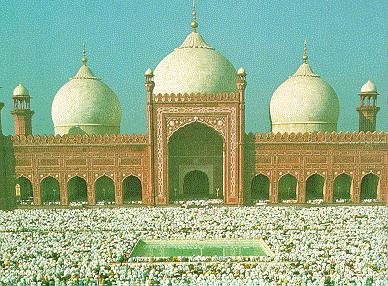
Badshahi Mosque, Lahore
The city next crops up in
literature in connection with the campaigns of the
Turkish dynast Mahmud of Ghazni against the Rajas of
Lahore between I00I and I008. Around this time it
established itself as the capital of the Punjab and
thereafter began to play an important and growing role
as a centre of Muslim power and influence in the
subcontinent. Its heyday was the Mughal era from the
early sixteenth century onwards and, as Mughal power
began to decline in the eighteenth and nineteenth
centuries, Lahore suffered a concomitant period of
ignominy and political eclipse. It was here, at the
beginning of the nineteenth century, that the Sikh ruler
Ranjit Singh declared himself Maharajah of the Punjab
and allowed his troops to desecrate many of the city's
beautiful Islamic shrines- including the Badshahi Mosque
which was, for a while, converted into a powder
magazine. By the time British occupied Lahore in I849,
one writer moved to describe the city as 'a mere expanse
of crumbling ruins'.
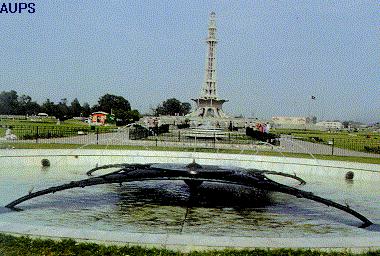
Minar-e-Pakistan, Lahore
Happily, this was an exaggeration
and today the great buildings laid down by the
long-vanished Mughal emperors may be seen in much of
their original splendour. All the adverse influences
since then seem to have been washed away, like sediment
carried off by a flood, leaving behind the fundamental
character and beauty of this old Islamic settlement.
Fittingly, it was here in I940 that the Muslim League
made its first formal demand for the establishment of a
Muslim homeland. A towering and graceful monument, the
Minar-e-Pakistan now stands on the site of the passing
of the Pakistan Resolution.
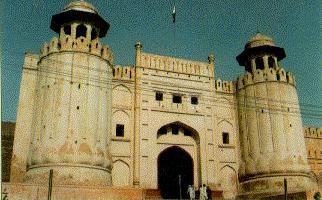
Lahore Fort, Lahore
Nearby, the massively fortified
walls of Lahore Fort speak eloquently of the centuries
of passing history that they have witnessed. The fort
antedates the coming of Mahmud of Ghazn i in the
eleventh century, was ruined by the Mangols in I241,
rebuilt in I267, destroyed a gain by Timurlane in I398
and rebuilt once more in I421. The great Mughal emperor
Akbar re placed its mud walls with solid brick masonry
in I566 and extended it northwards. Later Je hangir,
Shah Jehan and Aurangzeb all added the stamps of their
widely differing personalit ies to its fortification,
gateways and palaces.
The fort encloses an area of approximately thirty acres
and it is possible to spend many hours wandering there,
lost in contemplation of times gone by, trying to
reconstruct in your imagination a way of life that the
world will never see again. The buildings within its
walls are a testament to the gracious style of Mughal
rule at its height, in which every man knew his place
and courtly behaviour had been refined into an
elaborately startified social code. Much of the
architecture reflects this code. From a raised balcony
in the Diwan-e-Aam, or Hall of Public Audience, built by
Shah Jehan in I63I, the emperors looked down on the
common people over whom they ruled when they came to
present petitions and to request the settlement of
disputes. Wealthier citizens and the nobility were
allowed to meet their emperors on a level floor in the
Diwan-e-Khas, the Hall of Special Audience-which was
also built by Shah Jehan, in I633.
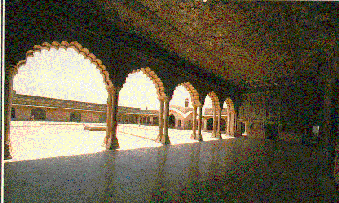
Shish Mahal, Lahore
While the Hall of Audience are
characterized by their strict functionality, other
buildings raised under Shah Jehan's patronage are styled
in a more imaginative and fanciful mood. Of these the
Shish Mahal, or Palace of Mirrors, which stands on the
fort's north side, is by far the most splendid. It
consists of a row of high domed rooms, the roofs of
which are decked out with hundreds of thousands of tiny
mirrors in the fashion of the traditional Punjabi craft
of "Shishgari" (designs made from mirror
fragments). A fire-brand lit inside any part of the
Palace of Mirrors throw back a million reflections that
dizzy the eye and seem like a galaxy of far-off stars
turning in an ink-blue firmament.
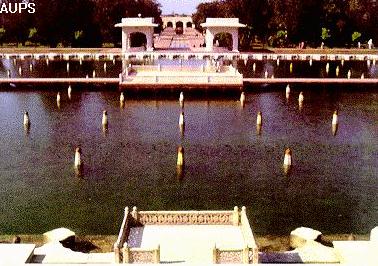
Shalimar Garden, Lahore
Another magnificent remnant of the
Mughal era, also partially vandalized in the late
eighteenth century by the invading Sikhs, is the
Shalimar Garden which stands on the Grand Trunk Road
about eight kilometers to the east of the old part of
Lahore. "Shalimar" means 'House of Joy' and,
in truth, the passing centuries have done nothing to
detract from the indefinable atmosphere of
light-heartedness and laughter that characterizes this
green and peaceful walled retreat. A canal runs the
entire 2,006 foot (6II meters) length of the garden and
from it 450 sparkling fountains throw up a skein of
fresh water that cools and refreshes the atmosphere,
making this a favourite place for afternoon walks for
the citizens of modern Lahore.
Lahore is rightly regarded as the cultural,
architectural and artistic center of Pakistan; indeed,
the city is so steeped in historical distinction that it
would be possible to spend a lifetime studying it
without learning everything that there is to learn.
FOR
MORE...
|
 | | | |
|


